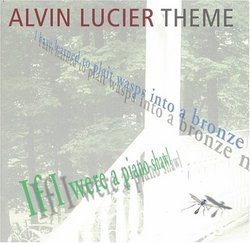| All Artists: Alvin Lucier, Lois Svard, Jacqueline Humbert, Joan La Barbara, Sam Ashley, Thomas Buckner Title: Theme Members Wishing: 3 Total Copies: 0 Label: Lovely Music Release Date: 1/25/2000 Genres: Dance & Electronic, New Age, Classical Styles: Electronica, Techno, Chamber Music, Historical Periods, Classical (c.1770-1830), Modern, 20th, & 21st Century Number of Discs: 1 SwapaCD Credits: 1 UPC: 745295501121 |
Search - Alvin Lucier, Lois Svard, Jacqueline Humbert :: Theme
 | Alvin Lucier, Lois Svard, Jacqueline Humbert Theme Genres: Dance & Electronic, New Age, Classical
Music for Piano with Magnetic Strings (22:58) A work in which the strings of a piano sound by themselves. Several EBows which cause the piano strings to vibrate and sound are placed on the strings of the piano. The pianis... more » |
Larger Image |
CD Details
Synopsis
Album Description
Music for Piano with Magnetic Strings (22:58) A work in which the strings of a piano sound by themselves. Several EBows which cause the piano strings to vibrate and sound are placed on the strings of the piano. The pianist works from a prose score which describes the process and suggests she freely position and reposition five EBows on the piano strings, creating strands of sounds of varying density and texture. Much of her time is spent listening for harmonics, audible beating, occasional rhythms produced as one or more magnets vibrates against adjacent strings, and other acoustic phenomena. Theme (18:45) Setting a poem of John Ashbery's to music, Lucier didn't want to violate the flow of the words of the poem by fragmentation or any other cut-up method. The stanzas seemed musical enough just as they were and he wanted the audience to hear the poem more or less in its pristine state, so, working intuitively and by ear, he wrote out the poem for four readers in the order it was written, repeating words and phrases, overlapping and superimposing them in various ways. To "set" the poem, he inserted microphones into the mouths of various vessels, including a small milk bottle, a sea shell, a vase and an empty ostrich egg, to pick up the words as they were sounding inside the vessels. The readers speak normally, allowing the pitches of their voices which match those resonances of the vessels to create musical sounds. Occasionally, however, a reader will tend to emphasize certain pitches more than others, reading in an almost chant-like way, to sound the resonances of the vessels more clearly. Music for Gamelan Instruments, Microphones, Amplifiers and Loudspeakers (15:09) Wanting to make a work for Javanese gamelan, but wary of using someone else's music in his own work, it wasn't until he started imagining the bowl-shaped bonangs of the gamelan orchestra more as resonant chambers to be sounded than objects to be struck, that Lucier felt he could make a work for gamelan that he could call his own. During the performance four players place bonangs of various sizes over microphones, creating feedback, the pitch of which is determined by the shape and size of the bowl and the resonant characteristics of the room. Three gender players strike the bars on their metallaphones, searching for the pitches of the feedback strands.

 Track Listings (3) - Disc #1
Track Listings (3) - Disc #1